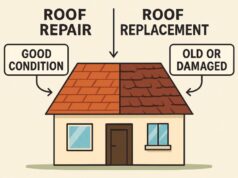Table of Contents:
- Inspect and Maintain Your Roof
- Secure Windows and Doors
- Clear Gutters and Downspouts
- Trim Trees and Secure Outdoor Items
- Install a Backup Power Source
- Prepare an Emergency Kit
- Review Your Insurance Coverage
- Develop a Family Emergency Plan
Severe weather events have become increasingly frequent and unpredictable, often with little warning. From intense thunderstorms and hail to hurricanes, tornadoes, and flooding, these natural forces can unleash destructive winds, torrential rain, and airborne debris—all of which pose significant threats to homes and personal safety. The key to minimizing the impact of these storms lies in preparation. Proactively safeguarding your property helps protect your loved ones and saves considerable money and stress in the aftermath. For homeowners especially concerned about the potential for storm-related damage, researching and contacting a trusted storm damage roofer before disaster strikes is a practical step toward resilience. Building a relationship with experts ahead of time ensures you’ll have immediate support available when you need it most, reducing your response time and helping you navigate repairs more efficiently.

Inspect and Maintain Your Roof
A roof inspection twice annually, ideally in spring and fall, is crucial for protecting your home from harsh weather. Look for common issues like cracked shingles, warped flashing, and signs of mold or leaks. Timely repairs are essential to prevent water intrusion, structural weakening, and mold growth. If you notice any additional damage, contact a professional storm damage roofer for detailed assessments and repair options, ensuring your roof is fortified before the next severe weather threat.
Secure Windows and Doors
During a violent storm, windows and doors are vulnerable entry points for wind, rain, and debris. Install storm shutters or plywood, caulk windows, weather-seal doors, and upgrade locks and latches to protect your home. Consider adding additional bracing for sliding doors. This will reduce interior damage risk and increase safety during extreme storms. Regular maintenance will protect your home against wind, rain, and debris.
Clear Gutters and Downspouts
Gutters and downspouts are crucial for protecting your home from water damage. Clogged gutters can cause roof leaks, rotting fascia boards, and foundation erosion. To prevent these issues, clean them at least twice a year, checking for misalignments, rust, holes, or disconnected joints. Install mesh gutter guards to deter debris buildup and make maintenance easier. This will ensure year-round home protection and save time.
Trim Trees and Secure Outdoor Items
Mature trees and landscaping can enhance a home’s beauty and value, but overhanging branches and unsecured outdoor items can pose significant hazards during severe storms. Regular tree maintenance, trimming branches, and removing poor-health trees can mitigate risk. Secure loose items like patio furniture, grills, and decorative garden features to prevent damage during storms. Store smaller items in garages or sheds, and use tie-downs or anchors for larger structures.
Install a Backup Power Source
Power outages during major storms can cause significant damage to homes, including endangering refrigerated food, disrupting medical devices, and causing security issues. To ensure comfort and safety, consider investing in a portable or standby generator sized for your household needs. Store fuel for several days, understand operating instructions, and keep generators outside to prevent carbon monoxide buildup. Regularly test and review generators to comply with safety regulations. Some homeowners also install battery backup systems or solar generators.
Prepare an Emergency Kit
A well-stocked emergency kit is essential for a household during severe weather disruptions. It should include at least one gallon of water per person per day, three days’ worth of non-perishable food items, multiple flashlights, a fully stocked first aid kit, all necessary medications, copies of critical documents, emergency cash, personal hygiene supplies, a multi-tool toolkit for minor repairs, and fully charged cell phones. Customize the kit to meet your family’s unique needs, including infants, the elderly, and pets. Check the kit twice yearly to replace expired items, restock depleted supplies, and update documentation as needed.
Review Your Insurance Coverage
Homeowners often overlook gaps in insurance coverage, particularly for storm damage. Hazards like flooding, hail, and tornadoes may be excluded or require separate endorsements. Before storm season, review policy documents, gather digital photos and receipts, and consult an insurance agent or broker to clarify coverage limits, exclusions, and claims processes. They can help adjust policies, suggest riders, and provide tailored advice for your property.
Develop a Family Emergency Plan
An emergency plan is crucial for ensuring everyone in a household knows how to respond and where to go during a storm. It should include identifying safe areas in the home, mapping out evacuation routes, and ensuring everyone can shut off utilities if needed. Establish communication methods, such as group texts or third-party check-in services, and decide on two emergency meeting places. If pets are involved, make specific plans for their evacuation. Practice using safe areas twice yearly, update evacuation routes, assign roles to members, and include elderly relatives or those with special needs. Regularly updating and rehearsing the plan can help reduce the risk of storm damage and ensure a calmer and more confident response in emergencies. These proactive measures will pay off in peace of mind and resilient recovery.







